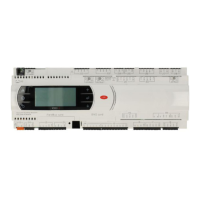53
ENG
pCO5plus +0300020EN rel. 1.2 - 07.11.2013
2) Enter the new value (e.g. 3) and click OK. The new value will appear in
the col
umn marked “scritto” [written]. To write the parameter to the pCO
controller, right-click and select “scrivi selezionate” [write selected]. The
new value will appear in the column marked “scritto” [written], meaning
that the parameter has been written to the controller.
Fig. 9.j
Click on “Salva” [Save] to generate the project’s “.2cw” fi le.
Commissioning: basic concepts
Note: The following paragraphs are from the online help of pCO
Manager, to which the user is referred for further details.
Commissioning is a confi guring and real-time monitoring software that
can be used to supervise the performance of an application program
installed on a pCO, to start up the pCO and to perform debugging and
maintenance.
With this software the user can set the confi guration parameters, edit the
values of volatile and permanent variables, save on fi le the trends of the
unit’s main quantities, manually manage the unit’s I/O using simulation fi les
and monitor/reset the alarms of the unit on which the device is installed.
Work carried out with Commissioning is preceded by confi guring the work
environment, which is typically done by the project designer. The active
project in 1Tool is automatically loaded by pCO Manager.
The project designer can use the confi guration functions of Commissioning
to decide which variables should be subjected to monitoring, logging,
trend-monitoring and event-monitoring, to organize variables into
categories and to create sets of confi guration parameters.
Operators using Commissioning for maintenance will be able to see the
necessary variables and to draw from preset confi guration values.
Support les
Once the design of the application is completed, 1Tool generates a
number of fi les in the compiling stage, two of which are required by
Commissioning:
• <nomeApplicativo>.2CF [<ApplicationName>.2CF] (variable descriptor)
• <nomeApplicativo>.2CD [<ApplicationName>.2CD] (category and
access profi le descriptor)
In addition to these fi les, the software also manages the <nome
applicativo>.DEV [<Application Name>.DEV] fi le, which contains the unit’s
preset parameters.
When the user has fi nished using Commissioning, whether for confi guration
or monitoring purposes, the following fi les can be generated:
• <nomeApplicativo>.2CW [<ApplicationName>.2CW] (descriptor for
categories, access profi les, monitoring groups)
• <nomefi leCommissioningLog>.CSV [<FilenameCommissioningLog>.
CSV] (fi le used for the commissioning log, containing data of the
variables logged during monitoring)
Therefore, to confi gure Commissioning the following fi les are required: .2CF,
2CD and, if necessary, the .DEV fi le, which can be imported or exported.
For monitoring purposes, in addition to the fi les above, it might also be
necessary to have the .2CW fi le, containing the defi nition of the work
environment. The commissioning log fi le is a simple output fi le.
pCO Load: basic concepts
pCOLoad is the module that manages:
• uploading to the fl ash memory (of the device or of the ProgKeyX key
installed on the pCO);
• uploading to the NAND memory of certain devices;
• downloading the log fi le, .DEV fi le and P memory (from the fl ash
memory);
• downloading fi les from the NAND memory, if present.
The fi les exchanged with the Flash memories of pCO controllers are:
• BOOT.BIN (download reserved, upload enabled from menu)
• BIOS.BIN (download reserved)
• <nomeApplicativo>.BLB [<ApplicationName>.BLB] (download
reserved)
• <nomeApplicativo>.BIN [<ApplicationName>.BIN] (download reserved)
• <nomeApplicativo>.DEV [<ApplicationName>.DEV]
• <nomeApplicativo>.GRT [<ApplicationName>.GRT] (upload only, from
which the .GRP fi le is extracted)
• <nomeApplicativo>.IUP [<ApplicationName>.IUP]
• <nomeApplicativo>.LCT [<ApplicationName>.LCT]
• <nomeApplicativo>.PVT [<ApplicationName>.PVT]
• <nomepCOlog>.BIN, <nomepCOlog>.CSV, <nomepCOlog_GRAPH>.
CSV [<pCOlogName>.BIN, <pCOlogName>.CSV, <pCOlog_
GRAPHName>.CSV] (only if log fi les have been confi gured, download
only).
The fi les exchanged with the NAND memories of pCO controllers are:
• any fi le that the pCO can independently copy to the fl ash memory (see
above list);
• external fi les (e.g. .pdf or .doc fi les for documentation).
LogEditor: basic concepts
LogEditor is the module used to confi gure the log fi les of pCO devices
(pCO logs). Confi guring pCO logs consists in defi ning a number of sets
of variables in which to specify which variables should be logged, the
logging method (by frequency or by event) and the minimum number
of loggings required. Confi guration is based on a binary fi le (.PVT – Public
Variable Table), which is generated by 1Tool and contains the descriptive
data of the variables that can be logged.
All the log confi gurations so defi ned are saved in the .LCT (Log
Confi guration Table) binary fi le, which must be uploaded to the pCO
together with the .PVT fi le. Log confi guration data is also saved in a fi le
that can be used only by LogEditor – the .LEF fi le, which must be saved to
be edited with LogEditor as necessary.
LogEditor can be used even when the device is not connected.
Once the fi les for logging are uploaded to the pCO, the pCO
saves the logged data in the following fi les:
• .BIN fi le containing all the data in binary format;
• .CSV fi le containing the same data in a generic format with values
separated by commas;
• *_GRAPH.CSV containing the same data to be used for charting purposes

